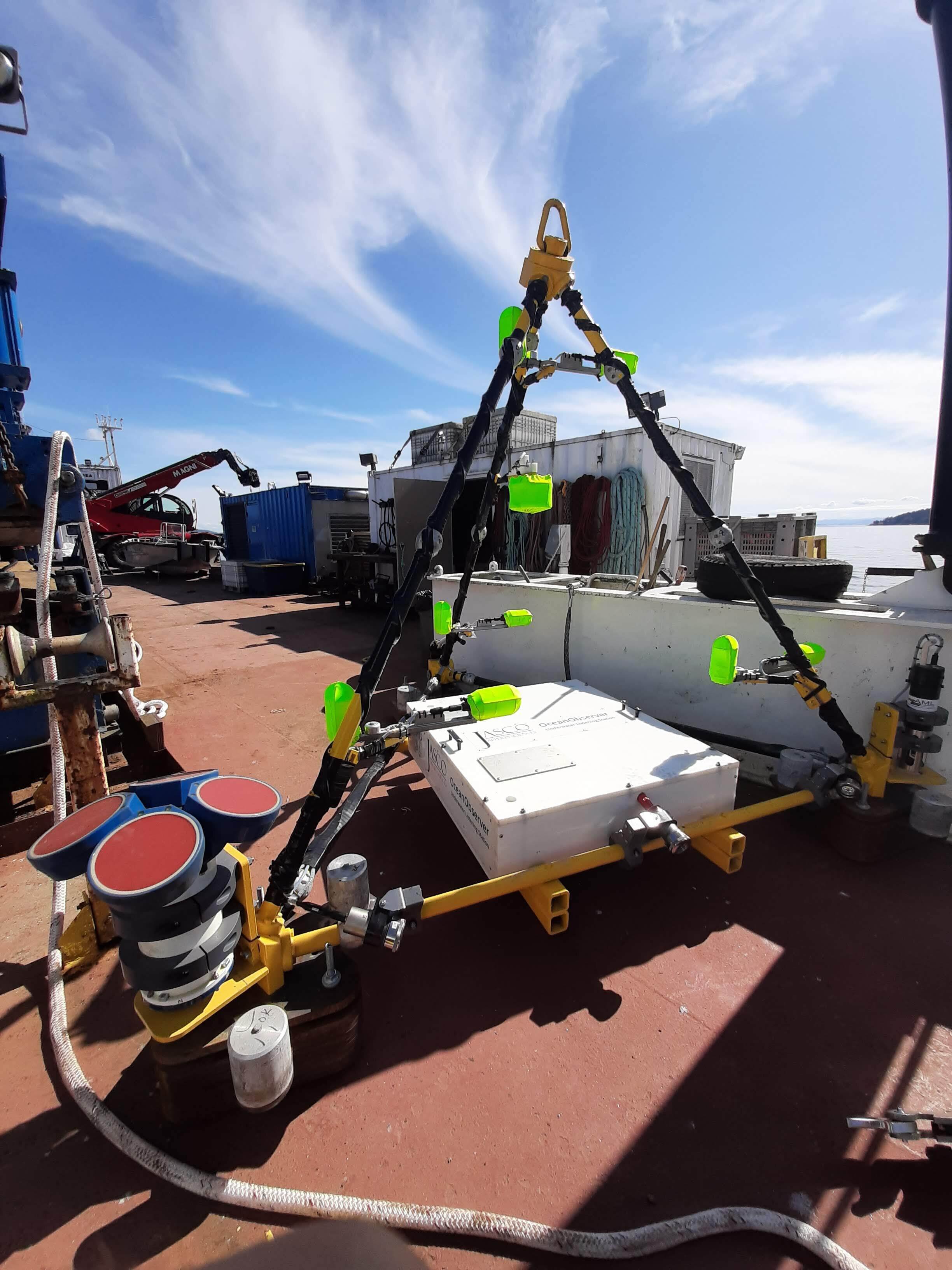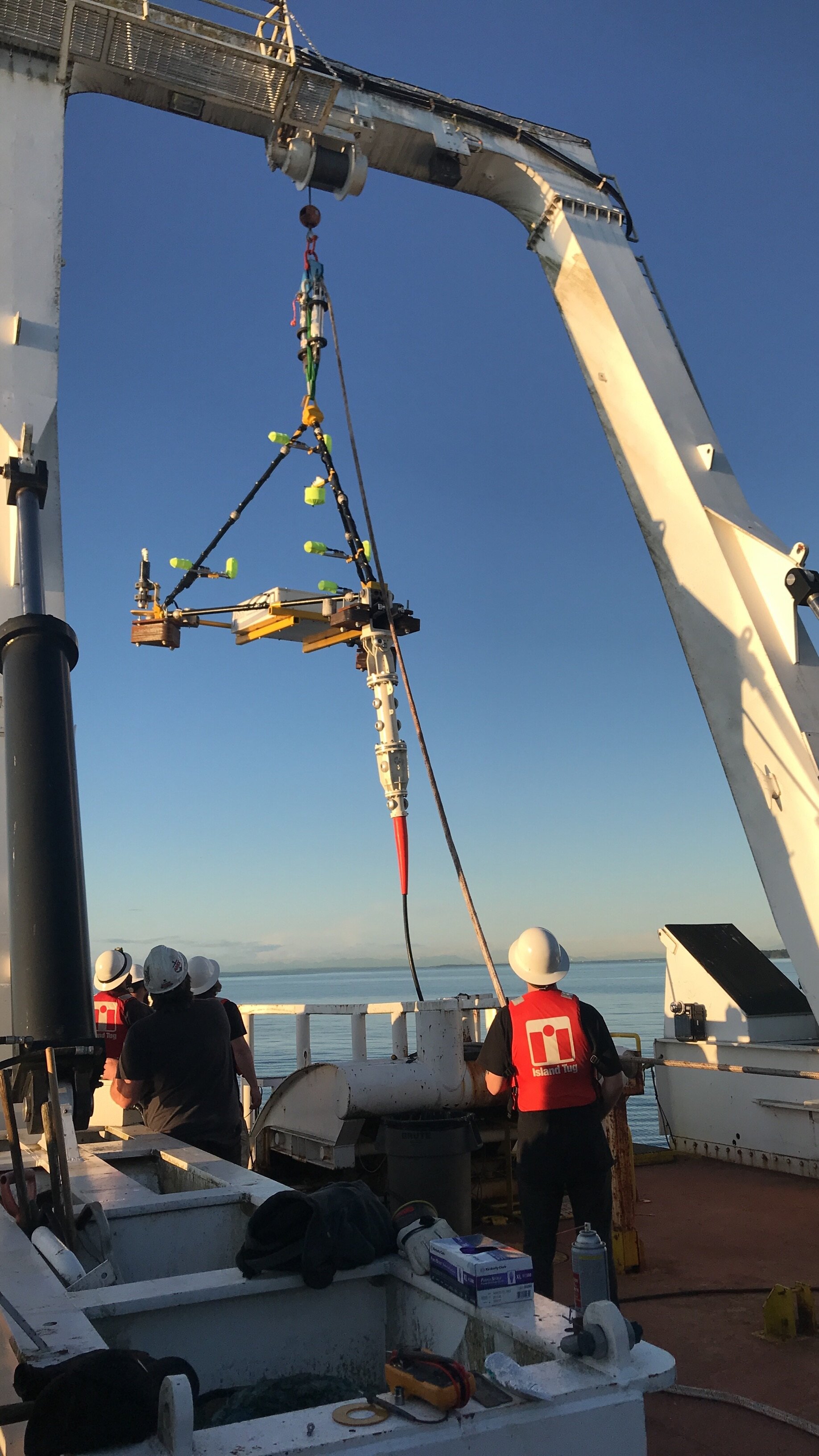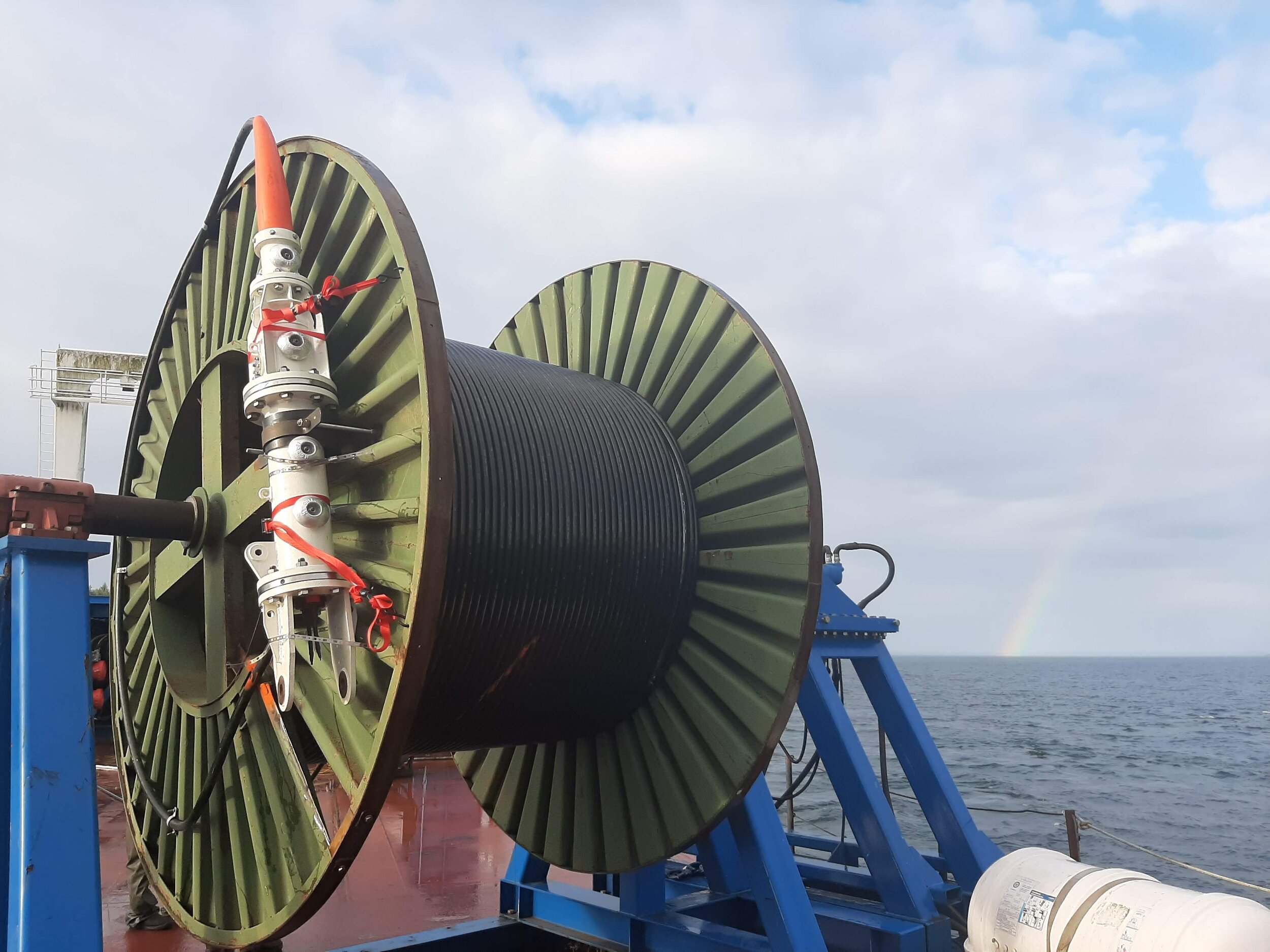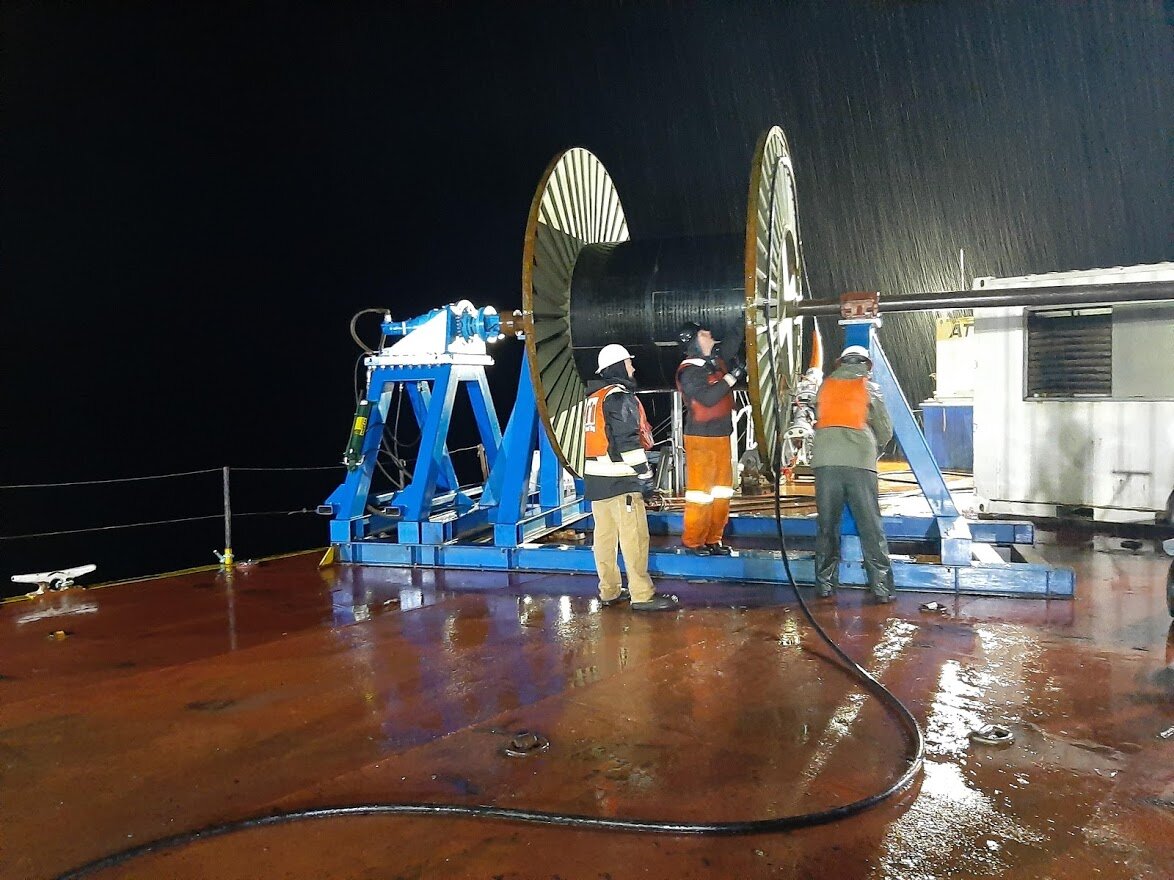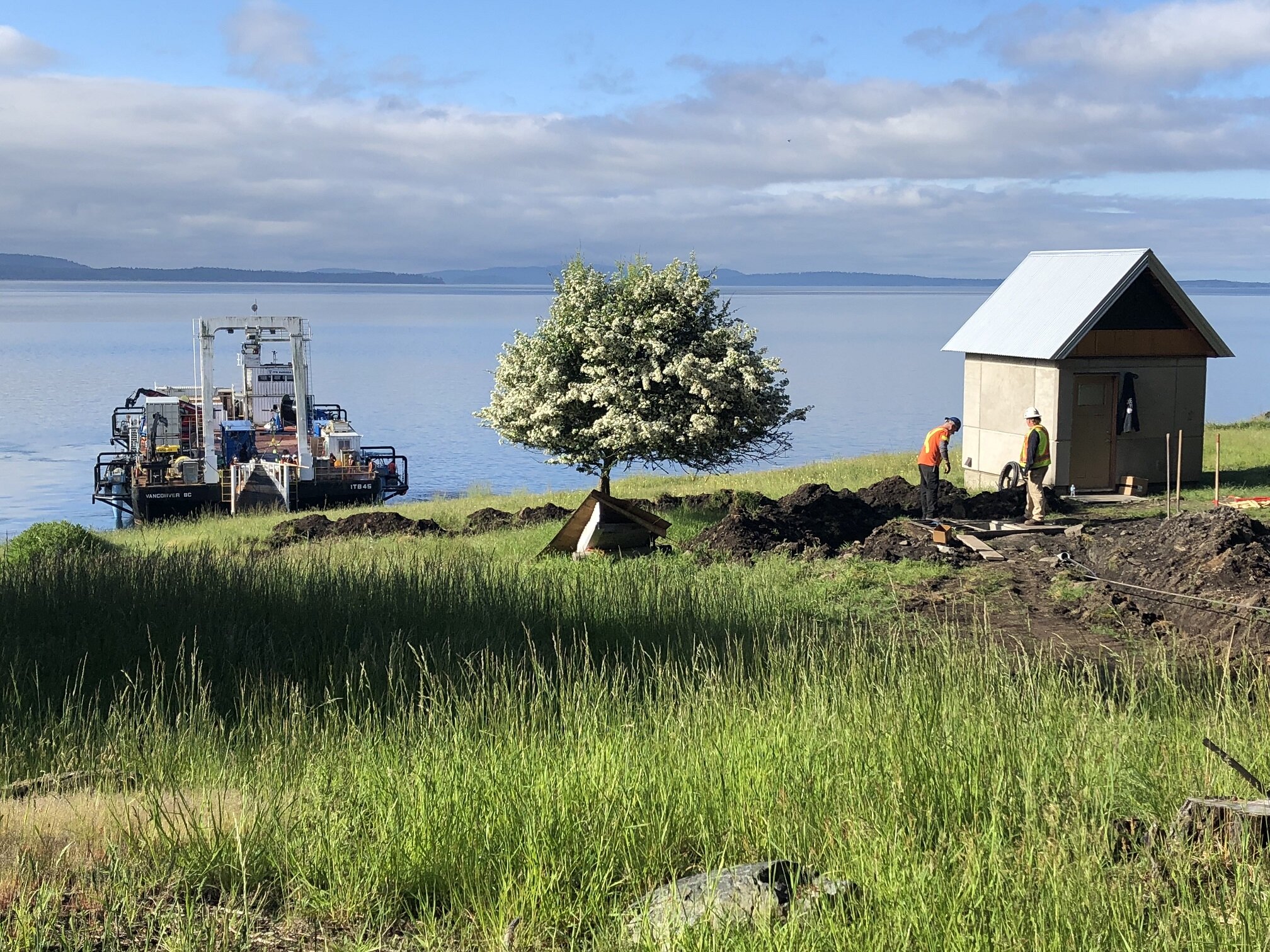For more information about this project or to request an underwater measurement report for your vessel, fill out a contact form below.
World-leading marine acoustic station—tracking cetaceans and measuring vessel noise
JASCO Applied Sciences installed a world-class Underwater Listening Station (ULS) in the Salish Sea to detect and track endangered whales and to measure underwater noise emissions of thousands of commercial vessels that frequent British Columbia’s southern ports. The station consists of two observation frames, each with eight underwater microphones (hydrophones), installed 190 metres (620 feet) below the shipping lanes of Boundary Pass, about 50 kilometres south of Vancouver.
“While Canada’s coasts and marine species are more protected than ever before, the Government of Canada remains committed to preserving and protecting our vulnerable marine environment. This underwater listening station in Boundary Pass is just one example of our international leadership in quiet vessel research and commitment to reducing the threat of underwater noise.”
A cabled underwater sound observatory
JASCO designed, manufactured, and deployed the cabled ULS between the shipping lanes leading to ports in Vancouver and southern British Columbia. This world-leading marine observation system lies within designated critical habitat of the endangered Southern Resident killer whale (SRKW).
Deployed in May 2020, on behalf of Transport Canada under the federal government’s Whales Initiative, the system is based on JASCO’s OceanObserver intelligent observing system. The ULS builds on the highly successful demonstration systems deployed by JASCO and Ocean Networks Canada in the Strait of Georgia between 2015 and 2018. The new Boundary Pass ULS incorporates:
Two hydrophone arrays
Video cameras
Ocean salinity, current, and temperature sensors
Numerous self-monitoring sensors to ensure system performance
The collected data are transmitted to shore along 2.8 kilometres of fiber-optic cables, allowing for immediate analysis and reporting of acoustic data and marine mammal detections. JASCO is operating the system and working with the Port of Vancouver’s Enhancing Cetacean Habitat and Observation (ECHO) Program to analyze and distribute the results.
“The Boundary Pass Listening Station is critical for understanding the noise emissions of the world’s commercial vessel fleet and its impact on the environment. By helping to define noise thresholds for international quiet ship certifications, these measurements will lead to noise savings for all the world’s oceans—an essential goal for ensuring the health and survival of at-risk species, including our Southern Resident killer whales.”
Three main goals
| 1. Vessel noise profiles | 2. Whale detection and tracking | 3. Noise levels over time |
|---|---|---|
| Systematically measure, adhering to international standards, the noise emissions of nearly every vessel entering and exiting ports near Vancouver and in Georgia Strait. Canada is an international leader in efforts to address underwater noise from vessels, and these results will support new-build design and quiet vessel certifications globally. The measurements will also allow accurate testing of the effectiveness of quieting technologies and operational measures. |
Detect and localize/track vocalizing cetaceans in Boundary Pass. This unique localizing capability can support real-time management of animal-vessel interactions to reduce adverse impacts. Documenting around-the-clock cetacean presence in Boundary Pass over several years will also add valuable scientific information about habitat use and behaviours of several species, including SRKW. |
Document the noise environment over many years in Boundary Pass. This allows us to evaluate the effectiveness of underwater noise management measures in this critically important habitat for endangered SRKW and other marine species. The long term ULS measurements of ambient and shipping noise provide valuable statistical information about the soundscape of this environment. |
Listening stations, 190 m (620 feet) deep
The ULS has two identical acoustic observatories. Each consists of a pyramid-shaped frame supporting acoustic, video, current, temperature, and salinity sensors. Each frame is equipped with JASCO OceanObservers connected to four primary hydrophones and four backup hydrophones. Together, the two observatories host 16 hydrophones that can operate simultaneously, but typically only eight hydrophones (four from each array) are operated at any given time. On the observatory frames, each set of four hydrophones is arranged in the shape of a tetrahedron/pyramid. This enables direction finding of sound sources, such as calling marine mammals and passing ships.
The two observatories are deployed 300 metres (980 feet) apart on the sand and gravel seabed of Boundary Pass, in 190 metres (620 feet) of water. Each observatory is connected by its own 2.8-kilometre-long subsea cable to a shore station on Saturna Island. Four layers of protective armour protect these specialized electrical and fiber-optic cables from the strong tidal currents and sharp rocky outcrops along the seafloor of Boundary Pass.
Before being transmitted, the myriad of data signals from the observatory sensors are combined into one signal by EMO Mini-T Multiplexers provided by MacArtney Canada Ltd. MacArtney worked closely with JASCO to develop a combined software/hardware solution for controlling the wide variety of equipment installed on each observatory.
3-D localization
The arrival directions of sounds at the observatories can be determined from the differences in the arrival times of the sounds at each hydrophone. And with the two synchronized arrays separated by a known distance, we can triangulate the position of a calling animal in 3 dimensions. We can even track and count individual animals as they swim past the ULS, provided they continue to make sounds. SRKW are highly vocal, so this approach is generally effective for localizing them.
Precise calibration, online data access
The precise calibration of each hydrophone is checked daily by playing faint reference sounds from an acoustic projector onboard each observatory frame. This calibration step ensures highly accurate measurements of absolute noise levels, a fundamental requirement for quantifying vessel noise signatures.
Onboard the ULS observatories, the OceanObserver systems process the acoustic data as it arrives to quantify sound levels and detect marine mammal calls. At the shore station, the data are fed in real-time to JASCO’s advanced automated data processing framework PortListen®. PortListen performs further analyses and provides immediate online access to the results through its cloud-based data portal. Through this portal, researchers can examine and listen to each marine mammal call detection. Ship noise emission measurements can be viewed and online reports are produced at the click of a button. Ambient noise results are available in multiple formats on daily, weekly, and monthly timescales.
Interim listening with autonomous recorders
During the months long preparation of the ULS—design, procurement, equipment assembly, testing, construction and permitting—JASCO conducted interim measurements with temporary acoustic moorings. Five separate deployments of calibrated AMARs (Autonomous Multichannel Acoustic Recorders) and water current profiling sensors were performed between December 2018 and June 2020 when the cabled ULS was up and running.
These recorders, deployed to the seabed, captured a very high quality acoustic data set over the entire interim monitoring period. Weather and vessel traffic data were also captured to support data analysis and interpretation.
A JASCO AMAR (Autonomous Multichannel Acoustic Recorder) and mooring system ready for deployment in Boundary Pass. Five such systems captured interim measurements until the ULS was in full operation.
Some great results!
The ULS project, with autonomous and now cabled monitoring systems, has measured the noise emissions of more than 30,000 vessel passes and the calls of thousands of marine mammals, including SRKWs as of September 2023. The developed ship noise database is now the largest repository of systematic vessel Underwater Radiated Noise measurements worldwide.
Watch these videos to hear just a sample of the whale calls we’ve recorded so far. Each video shows the spectrogram, which displays the sound frequency on the vertical axis and time is on the horizontal axis.
Video cameras on the observatories have captured numerous fish and bottom-dwelling animals and at least one giant pacific octopus (see video below). Scroll down for more recordings, videos, and photos.
A busy place at 600 feet!
The video feeds from the observatories have captured an array of marine life in the greeny depths of the Pacific. Some animals pass by quickly while others linger for a few hours or even days.
Even 190 metres below the surface (more than 620 feet), life abounds! Some stills from the video feeds are shown right.
The video cameras and spot-lighting are turned on for only 3 minutes of every hour. This prevent animals from habituating to the lights. It also gives us a more “candid” look at what’s happening on the seafloor. Still, the system collects more than an hour of video each day. We hope to engage high school or intermediate grade students to help us comb through the video to find what lies within — we have barely scratched the surface so far.
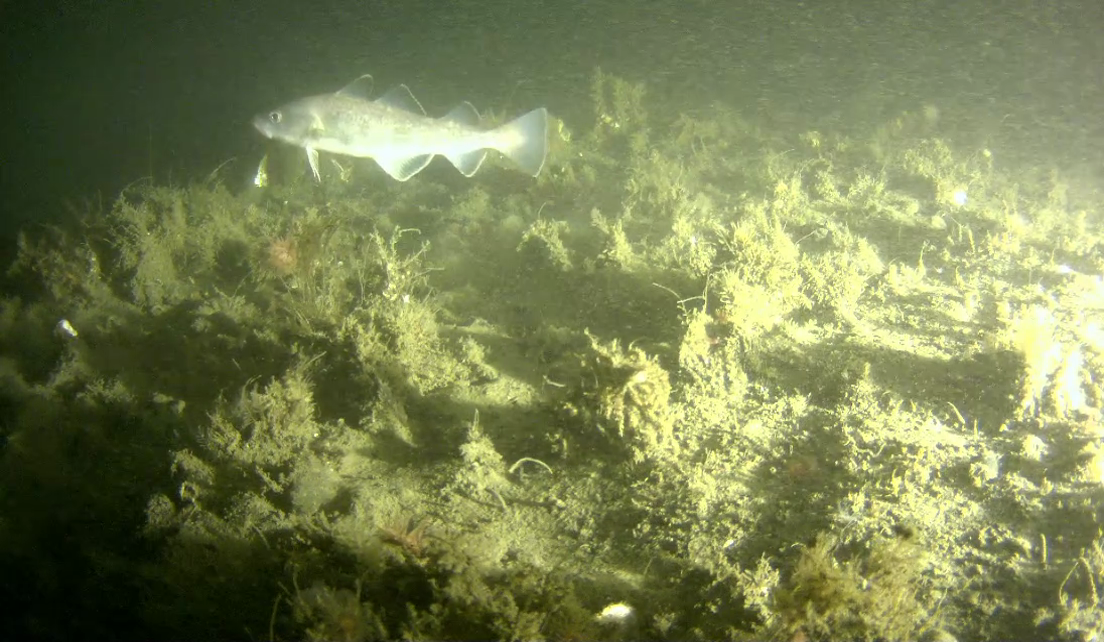
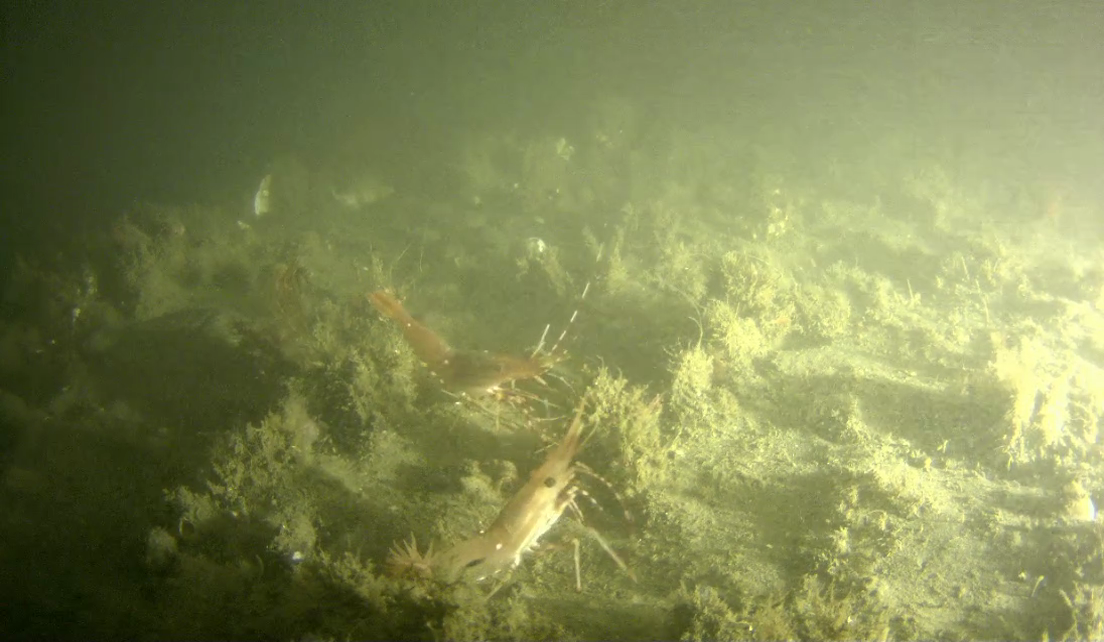
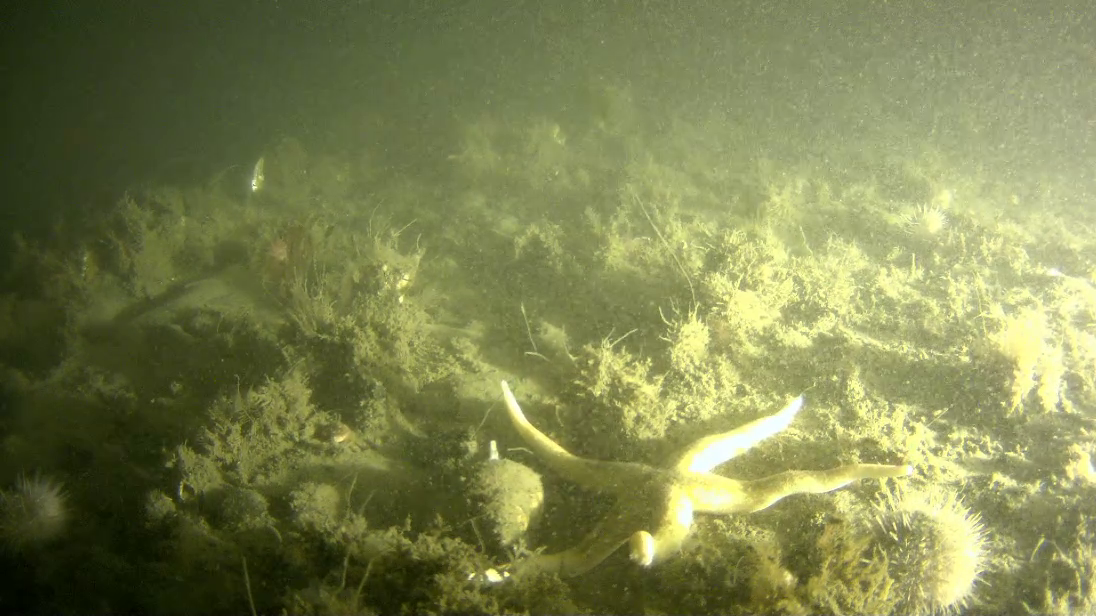

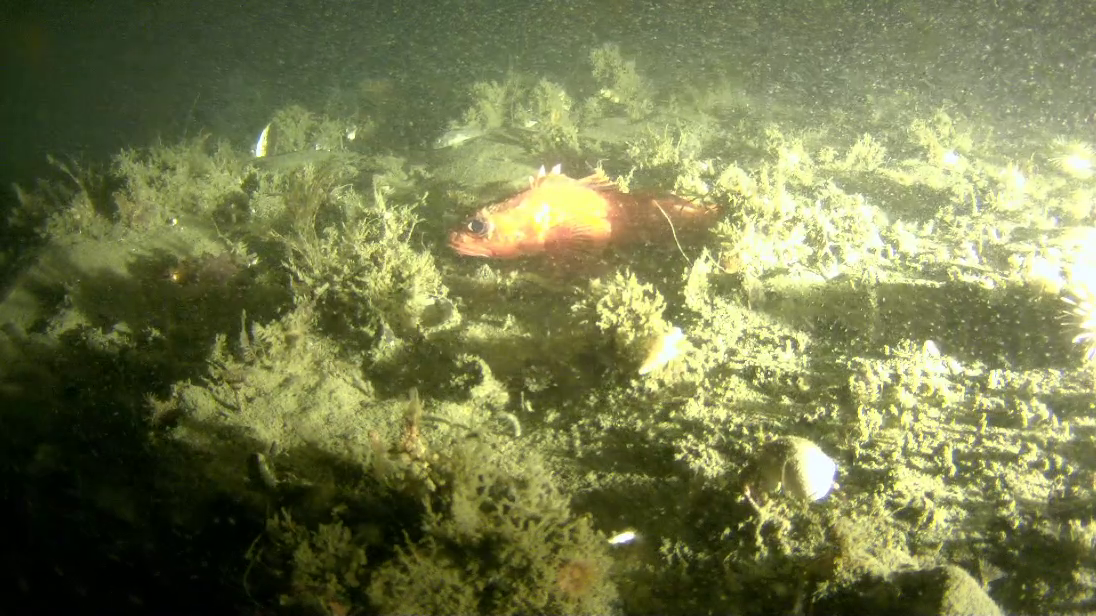
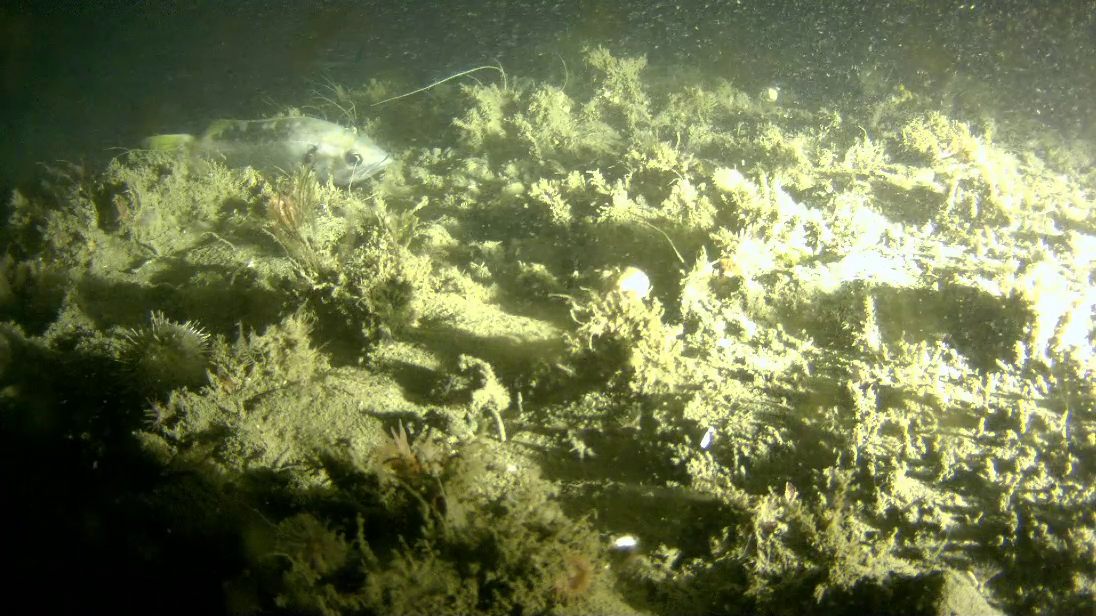
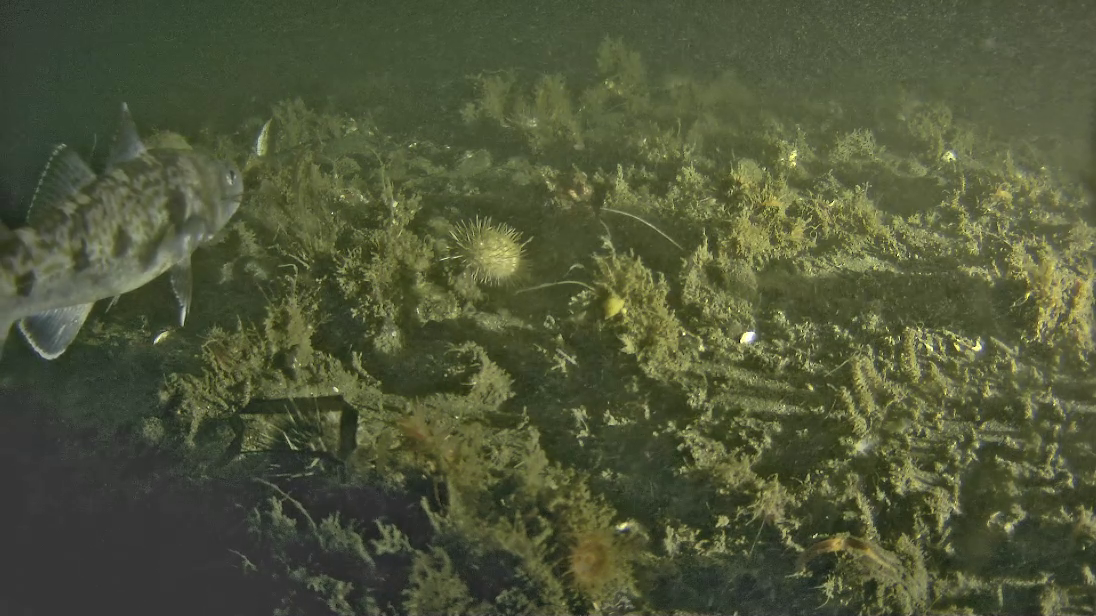

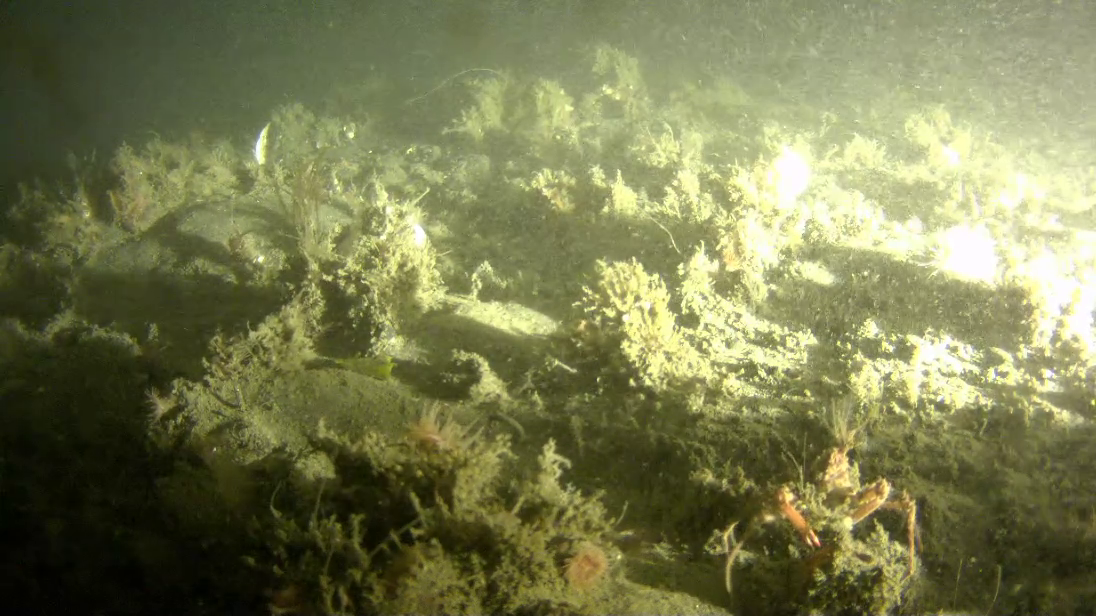
This underwater video of a giant Pacific octopus (Enteroctopus dofleini) was taken by the ULS in June 2020.
Octopus alert!
Watch as an 8-limbed visitor passes by on June 6, 2020.
It’s a giant Pacific octopus (Enteroctopus dofleini), the largest octopus species in the world. We estimate this one is at least 8 feet long!
Spoiler Alert: It’s pretty neat.
This species ranges throughout the Pacific Ocean, from southern California to Alaska, and as far west as Japan. Hunting at night, they subsist primarily on clams, shrimp, lobster, and fish. While their population numbers are unknown, we do know that cephalopods can be highly susceptible to effects of low-frequency underwater sound (Andre et al. 2011).
Live video stream
Check out this candid look at the bottom of the Salish Sea. This live stream shows a shuffled compilation of the 3-minute clips captured every hour.
Sometimes the images are crystal clear, and other times they are obscured by sediment stirred up by high tidal currents. We’ve seen fish, shrimp, urchins, and starfish roaming about, kelp and seaweed dancing in the current, and even our giant octopus friend on two occasions (well, we like to think it’s the same one…).
If you see the video go dark, don’t worry. That’s just the lights turning off a few seconds early at the end of a recording window so we’re sure they go off as planned.
Deploying the ULS
This time-lapse video shows one of the observatories of the underwater listening station being deployed in Boundary Pass in May 2020. The marine cable lay specialists at Island Tug and Barge led the charge, with JASCO engineers onboard to connect the subsea cable to the array.
The weight of the frame was transferred from the crane to the lifting cable that passes into the cable tractors (the large blue machines). Then, the cable tractors maintained tension on the subsea cable while slowly lowering the frame to the seabed. The lifting cable was disconnected from the frame via acoustic release and winched back up, completing the deployment.
The photos below show highlights from the 2-day-long deployment of the two observatories and the subsea cables that connect them to the shore station on Saturna Island.
Enabling research
The ever growing data set collected by the ULS will also facilitate future research, for example:
ID’ing fish sounds: By recording both underwater sound and video at the same time, researchers can determine what species is responsible for previously unidentified sounds. We can then detect the presence of those species, be it fish or other benthic animals, just by listening for them.
Tracking individual whales: The localization ability allows the tracking of sound sources in 3 dimensions — even tracking individual whales within a pod. This can allow the counting of calling individuals, which is not possible with most hydrophone systems. Recording vertical movements and characterize dive patterns is also possible.
Quieting noise sources on vessels: By locating individual sources of noise on large vessels, we can identify problem areas where underwater noise originates. Quieting technologies can then be targeted to the loudest of those sources. This ability can also help test the effectiveness of quieting technologies by listening to noise from specific sources on a vessel.
Tracking small vessels: The ULS’s ability to localize sound sources means that small vessels can be tracked up to many kilometres away. Understanding the traffic patterns of small boats, which usually aren’t equipped with AIS (locating) transmitters, is key to evaluating their impacts on at-risk species.
Characterizing habitats: Temperature, salinity, and current data help us understand water mass movements and characterize the marine habitat and how it changes over time.
Studying high frequencies: The acoustic systems of the ULS are state-of-the-art, recording all hydrophone signals at 500,000 samples per second with high resolution 24-bit audio. These sound recordings capture sonar frequencies to over 200 kHz that are often missed by lower-resolution recorders. While humans can’t hear these high frequencies, many marine mammals can. These animals might be affected by loud sonar sounds. The ULS can accurately characterize sounds through the full audible frequency range of all marine mammals. It can also detect high-frequency echolocation clicks of harbour and Dall’s porpoise, which can extend beyond 200 kHz.
Correlating with visual studies: Boundary Pass is a fairly narrow passage with accessible coastlines and good shore-based infrastructure for supporting visual research. Universities and local research organizations are already supporting student observers and photographic studies. Data from these studies can be correlated directly with acoustic measurements from the ULS.
Learn more
Many thanks to our partners:
“Evidence based decision making is driven by quality data. Hemmera was proud to be a part of this project with JASCO, which gathers hydroacoustic data that will empirically inform future policies to help protect the critically endangered Southern Resident killer whale population.”
“The Marine department of Terra Remote Sensing is proud to have participated in this essential and progressive Project, in our own backyard. Terra was involved in the initial site selection survey, as well as the installation of the ULS sensors on the seafloor. We look forward to seeing the results for years to come.”
“A key focus of the ECHO Program is supporting the recovery of Southern Resident killer whales, a species which uses sound to communicate, navigate and find their prey, and the Boundary Pass Station provides vital infrastructure to help us better understand underwater noise in our region. We are proud to partner with Transport Canada and JASCO on this world-leading project, which will provide key data to inform the ECHO Program in our work with the shipping industry and regional partners, and help us achieve our common goal of reducing underwater noise from ships.”








